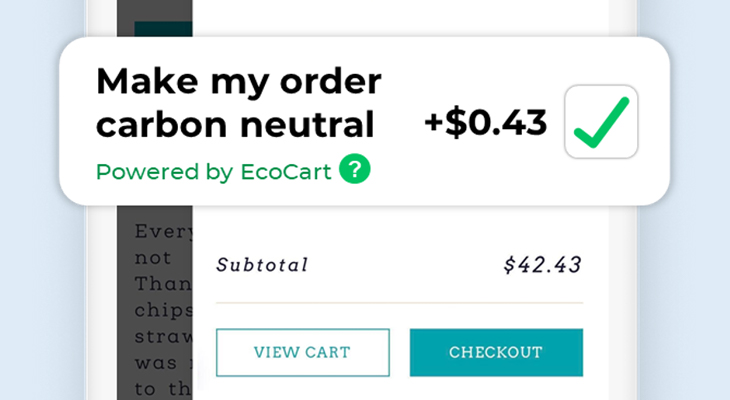Sustainable retail is about ensuring that your retail business aligns with greater ESG goals. This isn’t just important for compliance; today’s consumers demand that the businesses they support display proven sustainability, and many sustainable targets, like reducing energy consumption, can actually result in cost reduction. Therefore, sustainable retail is a win for everyone.
But, what does sustainability mean in retail, and how can you develop useful strategies for your ecommerce retail company? Here’s our guide.
What Is Sustainable Retail?
In short, sustainable retail ensures that all levels of a retail business, from manufacturing to logistics to product disposal, are environmentally and socially responsible. Sustainable retailers are committed to reducing their environmental impact while promoting ethical business practices and employee welfare, taking into account all three factors of ESG (environmental, social, and governance).
Although sustainable ecommerce and retail have always been important, consumer demand now necessitates retail sustainability initiatives. Eighty-five percent of people report shifting their purchase behavior toward more sustainable products and brands. In fact, 56% of consumers are willing to pay more for green products. Retailers that are not investing in sustainability efforts are at risk of falling behind their competition.
What Makes A Retail Business Sustainable?
A genuinely sustainable retail business will have a holistic approach to ESG principles. They will be able to demonstrate social and environmental sustainability at every level of operations. These will include net zero carbon emissions targets set forth by the major carbon standards, partnerships with manufacturers that can prove eco-friendly and socially responsible manufacturing practices, strategies for employee happiness and safety, initiatives to improve the sustainability of their supply chain, green business certifications, and more.
In order for sustainable retail to be claimed, a company in the retail industry must be able to exhibit ongoing pursuit of measurable sustainability goals that take into account all facets of operation. It’s not enough to promise sustainable material sourcing and call yourself a green ecommerce business. A truly sustainable retail business will invest in more sustainable materials and practices in all areas of operation, and they’ll continuously push themselves toward more sustainable practices even as their targets are achieved.

Why Sustainability In Retail Matters For Your Business
Sustainability in the retail industry matters for the same reasons it matters everywhere. As a global community, we need to do what we can to ensure that we reach the goals set forth by the Paris Agreement. Businesses, individuals, and governments must enact vigorous strategies to reduce our carbon footprint before the world’s temperature reaches dangerous levels.
Besides your carbon footprint, sustainable retail also ensures that the impact of your business is a positive one. Not only is this good for society and the environment, but it’s good for business, too. As many as 70% of consumers find sustainability to be important when choosing a brand to support, and retailers that aren’t seeking sustainability will be left behind.
Furthermore, legislation in the United States, E.U., Canada, and beyond require ESG reporting, due diligence along your supply chains, and other sustainable initiatives. Failure to comply could result in hefty fines. Long story short, sustainability in the retail sector doesn’t just matter; failure to be sustainable could be disastrous for business.
Want to know where your business stands? Get your sustainability scorecard with our quiz:
Sustainability Trends In Retail
Sustainability is not a trend. When determining which areas your company can focus on, don’t just jump onto whatever other retailers are focusing on. Choose the areas where your company has the most impact. For example, if you determine that your business carbon footprint is higher than it should be, create strategies to minimize your impact in that area.
There are a few key areas where retailers tend to have the most impact. Here are the sustainability approaches that could be most important in the future of ecommerce.
- Carbon emissions: Fashion retail, in particular, carries a notable GHG footprint—the fashion industry accounts for about 4% of annual GHG emissions across the globe. Fashion retailers, like women’s sustainable clothing brands, would do well to reduce this number by creating sustainability targets surrounding their carbon emissions.
- Energy consumption: By minimizing energy consumption and switching to renewable energy sources, retailers can reduce their reliance on fossil fuels, minimizing their carbon emissions, and reducing operational costs. Learn how to perform a business energy audit.
- Supply chain management: The majority of a company’s impact comes from outside of its operations. As eco-friendly online stores develop their sustainability strategies, they must partner with their manufacturers and supply chain to ensure that their sustainability goals align. Learn how to perform a supply chain audit.
- Waste management: Another key feature of a sustainable world is circularity. Rather than managing waste in a linear way, we must reuse and recycle used materials as much as possible. Sustainable retail needs to take waste management into account and invest in eco-friendly packaging, provide recycling receptacles in their facilities, educate and train their employees about circular waste management, and develop other strategies to reduce waste overall.
- Fairtrade: Although environmental impact is the most popular factor in sustainability, we can’t forget that sustainable business is about social responsibility, too. As retailers create their sustainability strategies, they must also remember to source from ethical suppliers that can prove fair trade practices.
Retail Sustainability Initiatives
When you’ve determined your larger sustainability goals (such as, improving energy efficiency, your waste management, reducing your carbon footprint, etc.), you can develop initiatives to achieve those goals. As you create your strategies, make sure that they are measurable and actionable.
For example, you can’t simply say, “We will reduce our greenhouse gas emissions.” You must create actionable goals, such as switching to LED lightbulbs in your facilities and eliminating plastic packaging, that will result in a specific reduction in carbon emissions by a certain end date.

You can set clear sustainability key performance indicators (KPIs) to help clarify your goals and create impactful initiatives.
Let’s take a look at some sustainability initiatives that you might implement in your company.
- Provide carbon-neutral shipping options. Another big area of impact for ecommerce is its carbon emissions associated with shipping. By offering a carbon-neutral shipping option, like that provided by EcoCart, you allow your customers to take responsibility for their footprint by supporting verified carbon offset projects.
- Invest in eco-friendly packaging. Within ecommerce, packaging constitutes a big portion of your impact. By investing in eco-friendly packaging, you can minimize plastic waste, encourage recycling, and promote circular waste management.
- Use recycled materials. Whenever possible, make use of recycled materials in your sustainable products and packaging. Using post-consumer plastic materials, for example, can help fight against marine plastic, reduce litter, minimize landfill waste, and promote circularity all in one go.
- Use renewable energy. By investing in solar power and other renewable energy sources, it will minimize your reliance on fossil fuels, support renewable energy initiatives, and reduce your operational costs.
- Use second-hand materials. Customers are seeking out eco-friendly clothing, which often makes use of second-hand materials. Recycled or used clothing minimizes waste and avoids virgin materials, both of which are good for the environment.
- Pay attention to sourcing. Make sure that you avoid virgin materials when possible, use green manufacturers, and follow your supply chains to avoid forced labor or unethical labor practices. This is especially important in fashion and for ethical jewelry brands.
- Use technology to track and understand your impact. There’s plenty of sustainability management software out there that can track your footprint and help you achieve your sustainability goals. EcoCart offers an emissions dashboard that shows you your emissions so that you can identify areas where you can improve.
Read more: Ecommerce in the Fashion Industry
Examples Of Sustainable Retailers
As you develop your sustainable retail strategy, it can be helpful to look at retailers who are already doing this well. Sustainability is not always intuitive nor straightforward, and it will take a lot of effort to create a sustainability strategy that’s effective, aligns with your customers, and still results in profit. Luckily, you don’t have to do it alone. Here are some excellent examples of other sustainable brands and retailers that EcoCart has had the pleasure of working with.

Nomad Goods
Nomad Goods, an electronics and lifestyle company, seeks to enact sustainability initiatives at all levels of operations. It’s working toward carbon neutrality, adjusting its targets every year to do better. Furthermore, it has partnered with multiple projects to offset its impact in many different ways. It’s also committed to reducing waste by omitting add-ons, like power adaptors, that may not be necessary. These approaches, and more, showcase a comprehensive approach to sustainability as Nomad Goods addresses internal and external sustainability factors in order to improve its impact.

LSKD
LSKD is a sportswear company that’s also committed to sustainability. Its values offer a good example of a company that includes social issues as part of its sustainability strategy. It focuses on diversity and inclusion as part of its business strategy, boasting social responsibility as well as environmental responsibility. It also uses biodegradable shipping bags, recycled polyester, and other sustainable materials in order to reduce waste. Like Nomad Goods, LSKD analyzes its impact regularly to strategize ways to always do better.

Wildway
Wildway provides organic, ethically sourced snacks and food to its customers. Its commitment to sustainability includes things like using recycled plastic, initiatives to reduce its GHG footprint, eco-farming, and more. It also carries numerous green certifications, proving its commitment to its customers.
Sustainable Retail FAQ
Let’s take a look at some quick questions and answers to clarify what we mean by sustainable retail.
What does ESG mean in retail?
In retail, ESG (environment, social, governance) means enacting initiatives to ensure environmental and social responsibility and upstanding business practices. Retailers that are serious about their ESG will need to analyze their environmental impact (carbon footprint, waste management, energy usage, etc.), social impact (their influence on the communities in which they work, where and how their sustainable products are sourced, etc.), and company operations (employee wellbeing, diversity, decision-making process, etc.) to ensure that they leave only a positive impact behind.
What can retail companies do to be more sustainable?
To be more sustainable, retail companies must first conduct a sustainability audit to see their current impact and then develop strategies to improve their impact. Ideally, they will develop initiatives to improve all areas; however, as their budget and resources allow, they should at least work on improving their most impactful areas and expand from there.
What is a good example of sustainability in business?
A good example of achieving sustainability in business would be a company that’s taking a holistic approach to sustainability and has measurable goals to improve its social and environmental responsibility, and governance. Sustainable businesses also take their suppliers into account and do their due diligence so that their supply chains align with their sustainability goals, too.
How can brands communicate their sustainability efforts with customers?
Brands can communicate their sustainability efforts by being transparent about their current impact and goals for the future, sharing sustainability progress on their social media channels, printing their sustainability story on their eco-friendly packaging, and more. EcoCart offers some resources to help our customers share their sustainability journey in a meaningful way.
Conclusion
Sustainability in retail is not easy to achieve, nor should it be. As a global community, we need to do a lot of work to reduce our impact and leave a prosperous planet for future generations. It takes a concerted, holistic effort if we are to achieve sustainability priorities and greater goals. Luckily, EcoCart can be a meaningful partner as you work toward your sustainability endeavors.
Interested in learning more? Reach out to our team for a demo today.



